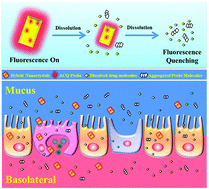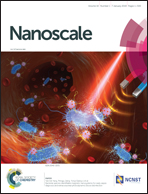Self-discriminating fluorescent hybrid nanocrystals: efficient and accurate tracking of translocation via oral delivery†
Abstract
The in vivo fate of nanocrystals is a controversial topic, i.e. dissolving versus integral absorption through the intestinal membrane. This is due to the lack of functional strategies to identify integral nanocrystals. In this study, the in vivo fate of quercetin hybrid nanocrystals (QT-HNCs) via the oral route is explored by physically embedding an environment-responsive probe in the crystal lattices of quercetin. The specific property of the probe is the water-initiated aggregation-caused quenching (ACQ) ability, by which integral QT-HNCs can be self-discriminated. Instead of dissolving instantly, QT-HNCs can be retained in the gastrointestinal tract for 12–16 h, and can then be absorbed and distributed into various organs with the liver as the primary terminal. The ileum provides better absorption than the jejunum. Cellular studies prove that both trans-epithelial and M cell-mediated routes are involved in the absorption of integral QT-HNCs, which may be impeded by the mucous layer. Moreover, the particle size affects the in vivo behavior and the ex vivo cellular interaction of QT-HNCs, with moderate size, such as 550 nm, being preferred. The results not only validate the idea of using ACQ fluorophores for bioimaging of integral nanocrystals but also support the intestinal absorption of nanocrystals.



 Please wait while we load your content...
Please wait while we load your content...